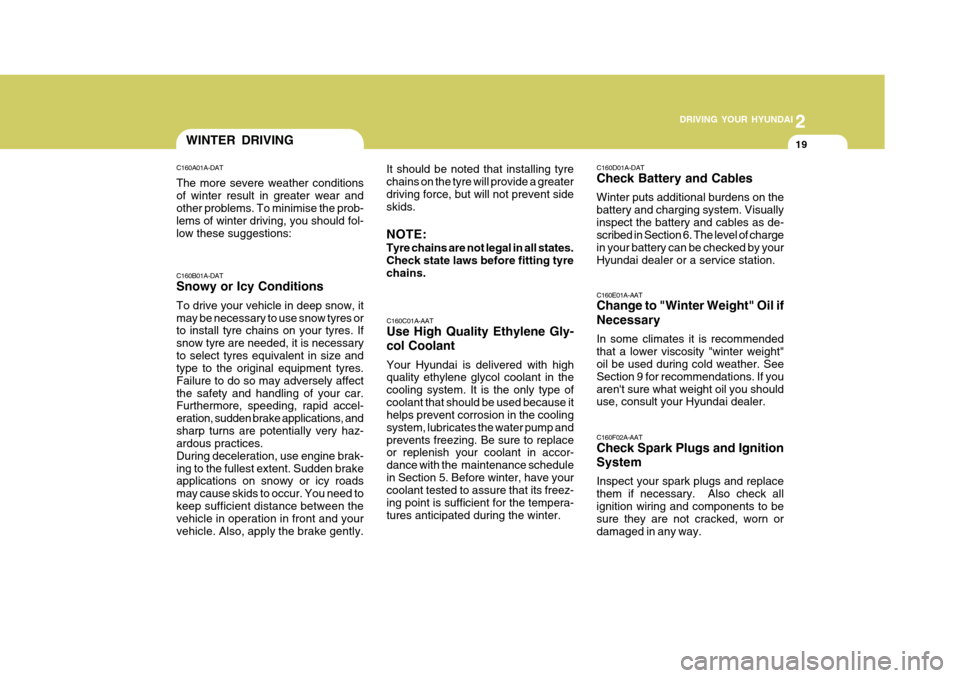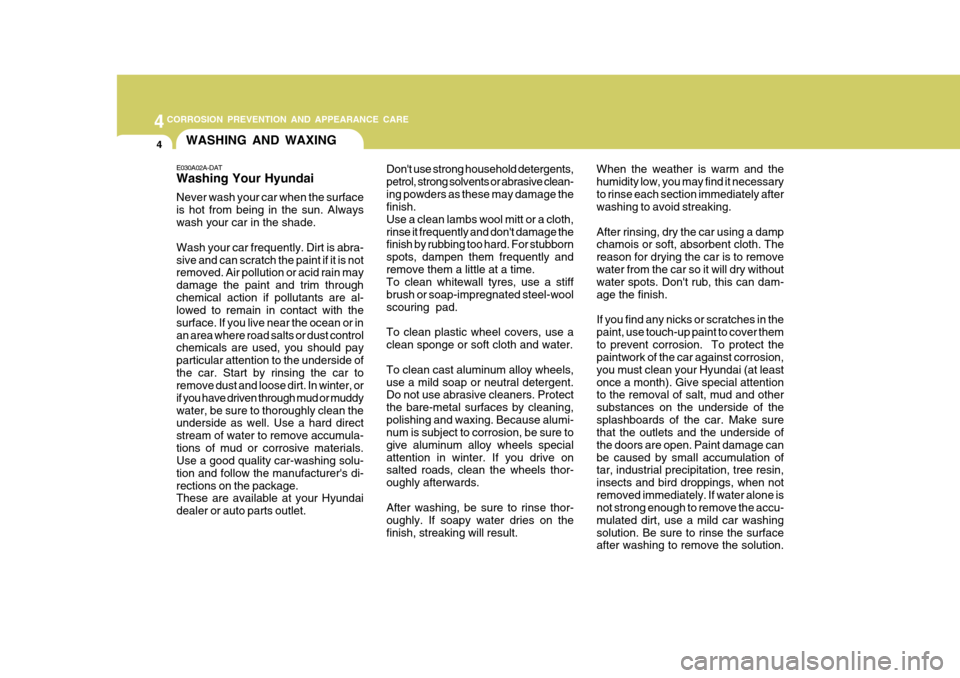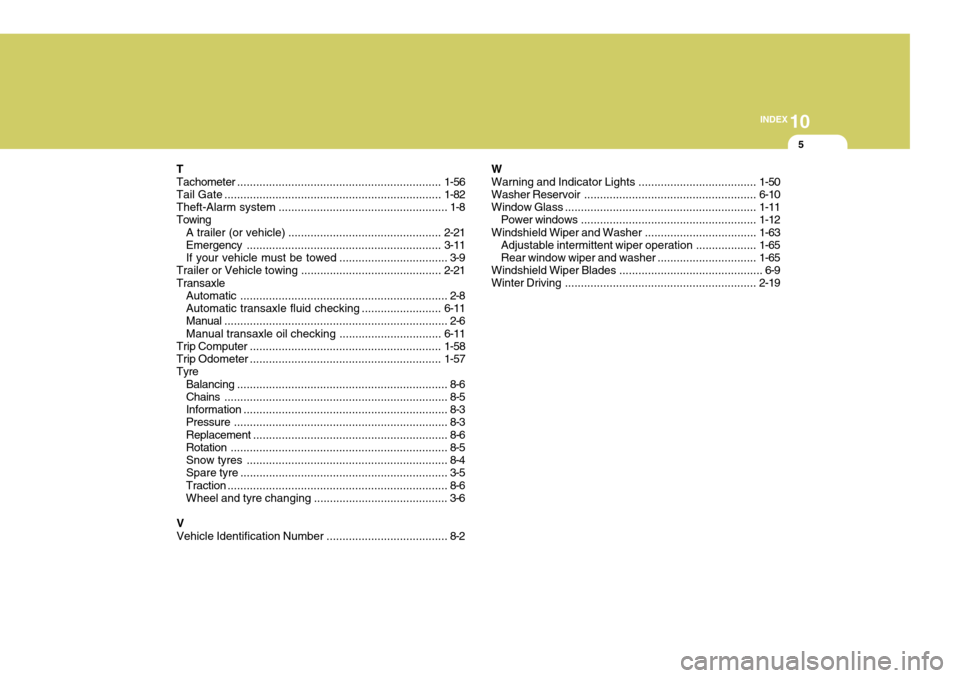2009 Hyundai Accent winter tyres
[x] Cancel search: winter tyresPage 146 of 232

2
DRIVING YOUR HYUNDAI
19
2
DRIVING YOUR HYUNDAI
19
C160C01A-AAT Use High Quality Ethylene Gly- col Coolant Your Hyundai is delivered with high quality ethylene glycol coolant in the cooling system. It is the only type ofcoolant that should be used because it helps prevent corrosion in the cooling system, lubricates the water pump andprevents freezing. Be sure to replace or replenish your coolant in accor- dance with the maintenance schedulein Section 5. Before winter, have your coolant tested to assure that its freez- ing point is sufficient for the tempera-tures anticipated during the winter.
It should be noted that installing tyrechains on the tyre will provide a greaterdriving force, but will not prevent side skids. NOTE: Tyre chains are not legal in all states. Check state laws before fitting tyrechains.WINTER DRIVING
C160B01A-DAT Snowy or Icy Conditions To drive your vehicle in deep snow, it may be necessary to use snow tyres or to install tyre chains on your tyres. If snow tyre are needed, it is necessaryto select tyres equivalent in size and type to the original equipment tyres. Failure to do so may adversely affectthe safety and handling of your car. Furthermore, speeding, rapid accel- eration, sudden brake applications, andsharp turns are potentially very haz- ardous practices. During deceleration, use engine brak-ing to the fullest extent. Sudden brake applications on snowy or icy roads may cause skids to occur. You need to
keep sufficient distance between the vehicle in operation in front and your vehicle. Also, apply the brake gently.
C160A01A-DAT The more severe weather conditions of winter result in greater wear and other problems. To minimise the prob- lems of winter driving, you should fol-low these suggestions:
C160F02A-AAT Check Spark Plugs and Ignition System Inspect your spark plugs and replace them if necessary. Also check allignition wiring and components to be sure they are not cracked, worn or damaged in any way.
C160E01A-AAT Change to "Winter Weight" Oil if Necessary In some climates it is recommended that a lower viscosity "winter weight" oil be used during cold weather. See Section 9 for recommendations. If youaren't sure what weight oil you should use, consult your Hyundai dealer.
C160D01A-DAT Check Battery and Cables Winter puts additional burdens on the battery and charging system. Visuallyinspect the battery and cables as de- scribed in Section 6. The level of charge in your battery can be checked by yourHyundai dealer or a service station.
Page 169 of 232

44CORROSION PREVENTION AND APPEARANCE CARE
4WASHING AND WAXING
Don't use strong household detergents, petrol, strong solvents or abrasive clean-ing powders as these may damage the finish. Use a clean lambs wool mitt or a cloth,rinse it frequently and don't damage the finish by rubbing too hard. For stubborn spots, dampen them frequently andremove them a little at a time. To clean whitewall tyres, use a stiff brush or soap-impregnated steel-woolscouring pad. To clean plastic wheel covers, use a clean sponge or soft cloth and water. To clean cast aluminum alloy wheels, use a mild soap or neutral detergent. Do not use abrasive cleaners. Protect the bare-metal surfaces by cleaning,polishing and waxing. Because alumi- num is subject to corrosion, be sure to give aluminum alloy wheels specialattention in winter. If you drive on salted roads, clean the wheels thor- oughly afterwards. After washing, be sure to rinse thor- oughly. If soapy water dries on thefinish, streaking will result. When the weather is warm and thehumidity low, you may find it necessaryto rinse each section immediately after washing to avoid streaking. After rinsing, dry the car using a damp chamois or soft, absorbent cloth. The reason for drying the car is to removewater from the car so it will dry without water spots. Don't rub, this can dam- age the finish. If you find any nicks or scratches in the paint, use touch-up paint to cover themto prevent corrosion. To protect the paintwork of the car against corrosion, you must clean your Hyundai (at leastonce a month). Give special attention to the removal of salt, mud and other substances on the underside of thesplashboards of the car. Make sure that the outlets and the underside of the doors are open. Paint damage canbe caused by small accumulation of tar, industrial precipitation, tree resin, insects and bird droppings, when notremoved immediately. If water alone is not strong enough to remove the accu- mulated dirt, use a mild car washingsolution. Be sure to rinse the surface after washing to remove the solution.
E030A02A-DAT Washing Your Hyundai Never wash your car when the surface is hot from being in the sun. Alwayswash your car in the shade. Wash your car frequently. Dirt is abra- sive and can scratch the paint if it is not removed. Air pollution or acid rain may damage the paint and trim throughchemical action if pollutants are al- lowed to remain in contact with the surface. If you live near the ocean or inan area where road salts or dust control chemicals are used, you should pay particular attention to the underside ofthe car. Start by rinsing the car to remove dust and loose dirt. In winter, or if you have driven through mud or muddywater, be sure to thoroughly clean the underside as well. Use a hard direct stream of water to remove accumula-tions of mud or corrosive materials. Use a good quality car-washing solu- tion and follow the manufacturer's di-rections on the package. These are available at your Hyundai dealer or auto parts outlet.
Page 232 of 232

10
INDEX
5
T Tachometer ................................................................ 1-56
Tail Gate .................................................................... 1-82
Theft-Alarm system ..................................................... 1-8
Towing
A trailer (or vehicle) ................................................ 2-21
Emergency ............................................................. 3-11
If your vehicle must be towed .................................. 3-9
Trailer or Vehicl e towing ............................................ 2-21
Transaxle Automatic ................................................................. 2-8
Automatic transaxle fluid checking ......................... 6-11
Manual ...................................................................... 2-6
Manual transaxle oil checking ................................ 6-11
Trip Computer ............................................................ 1-58
Trip Odometer ............................................................ 1-57
Tyre
Balancing .................................................................. 8-6
Chains ...................................................................... 8-5
Information ................................................................ 8-3
Pressure ................................................................... 8-3
Replacement ............................................................. 8-6
Rotation .................................................................... 8-5
Snow tyres ............................................................... 8-4
Spare tyre ................................................................. 3-5Traction ..................................................................... 8-6
Wheel and tyre changing .......................................... 3-6
VVehicle Identifi cation Number ...................................... 8-2 WWarning and Indicator
Lights ..................................... 1-50
Washer Reservoir ...................................................... 6-10
Window Glass ............................................................ 1-11
Power windows ....................................................... 1-12
Windshield Wiper and Washer ...................................1-63
Adjustable intermittent wiper operation ...................1-65
Rear window wiper and washer ...............................1-65
Windshield Wiper Blades ............................................. 6-9
Winter Driving ............................................................ 2-19